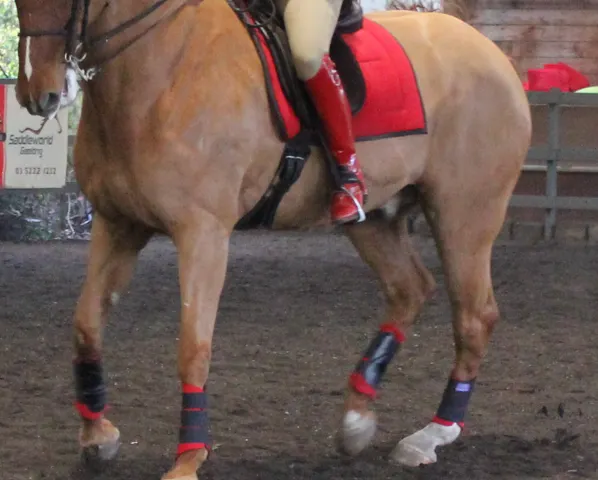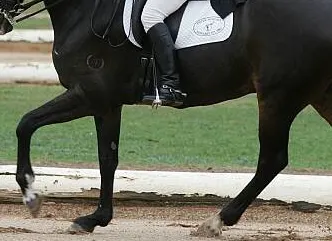Understanding the Rider's Leg in Horse Riding: From Backing to Advanced Training
When you think of a rider's aids, the first things that come to mind are usually the hands, the reins, and the saddle. However, one of the most important and often underappreciated aids in horse riding is the rider's leg. It is the key to maintaining balance, control, and communication with your horse, and it plays a crucial role in the education and training of the horse throughout its journey, from the initial backing process to the highest levels of competition.
During this blog we will discover the role and meaning of the rider’s leg, exploring how it is used at different stages of a horse's education. We’ll also touch on the use of spurs, when and how they should be used, and how riders can refine their leg aids for clearer communication with their horses.

The Rider’s Leg:
A Key Aid in Horse Riding
Before we hit the specifics, let’s first consider the general role of the rider’s leg. The rider’s legs serve as one of the primary means of communication with the horse, alongside the reins and the seat. Through subtle pressure, a rider can ask for direction, movement, and even speed changes. The legs help guide the horse forward, sideways, and even collect or extend its movement. Without a well-educated leg, riders may struggle to communicate effectively with their horses, which can lead to misunderstandings or misbehaviours.
The Role of the Rider’s Leg in the Backing Process
The first stage of a horse’s education is often referred to as the "backing process" – when the horse is first introduced to the rider’s weight, the saddle, and the concept of being ridden. At this stage, the horse’s understanding of the rider’s leg is very basic. The rider’s leg is primarily used to encourage forward movement.
Initially, the leg should be soft and gentle, as the horse is just getting used to carrying the rider. The rider’s leg should be applied with just enough pressure to signal the horse to move forward without causing discomfort or confusion. It's important that the rider does not use excessive pressure, as this can create resistance or lead to a tense relationship between the rider and the horse.
During this stage, the rider should focus on building trust and comfort. When the horse responds to the leg aid, even in small ways, the rider should reward the horse with release and praise. This positive reinforcement teaches the horse that responding to the rider’s leg is a good thing and that forward movement is rewarded.
Developing the Rider’s Leg Through the Horse’s Education
As the horse progresses through its education, the rider’s use of the leg becomes more refined. Once the basics of forward movement are established, the rider can begin to use the leg for more specific commands.
Lateral Movement and Leg Yielding
As the horse learns to accept the rider’s aids and becomes more balanced and coordinated, the rider can start to use the leg for sideways movements, such as leg yielding. Yielding to the riders leg is a movement where the horse moves sideways in response to pressure from the rider’s inside leg. This movement is a fundamental skill in any horse’s training, as it helps to build balance and flexibility.
At this stage, the rider’s leg needs to be applied with more precision. The rider’s inside leg applies pressure to ask the horse to move his/her body sideways, while the outside leg provides support and keeps the horse straight. It’s important that the rider maintains a stable seat and uses the legs with a clear, consistent aid.
Developing Collection and Engagement
As the horse progresses through its training, the rider’s leg also plays a critical role in developing collection and engagement. Collection refers to the horse's ability to shorten its stride and flex the pelvis, which we need for advanced movements such as piaffe, passage and pirouettes..
At this stage, the rider’s leg should be used to ask the horse to engage its hindquarters. The leg should apply subtle pressure, with the goal of encouraging the horse to have more activity with his/her hind legs. This requires the rider to be very sensitive to the horse's response to the leg and to release the pressure as soon as the horse responds correctly.

Maintaining Forward Momentum and Responsiveness
Even in more advanced stages, the rider’s leg remains an essential tool for maintaining forward momentum and responsiveness. A horse must be trained to respond promptly to the rider’s leg, as this forms the basis for the horse’s ability to perform more advanced movements.
At the highest levels of training, the rider’s leg must be used to communicate clearly and quickly, as the movements become more complex and demanding. The rider’s leg is used to aid in collection, lateral movements or specific gait changes and it must be applied with precision and finesse. The more refined the rider’s leg aids become, the more the horse will respond with lightness.
The Use of Spurs:
A Tool for Precision
Spurs are a tool that some riders use to aid in the communication with their horse, but they should not be seen as a substitute for effective leg aids. Spurs are most commonly used in advanced training, where more precise communication is required. The rider uses spurs as an aid to encourage the horse to respond more clearly to the leg, especially in situations where the horse may not be as responsive or is distracted.
However, spurs must be used with caution. They should never be used as a punishment or as a way to force the horse to respond. Instead, they should be used as a way to provide a clearer, more refined aid when the rider’s leg alone is not enough. When used correctly, spurs can be a valuable tool for refining the horse’s responses, but they should always be used with care and with the horse’s comfort in mind.
When and How to Use Spurs
Spurs should only be used when the rider has developed a strong, independent seat and can apply their leg aids effectively without relying on the spurs. They should never be used in the early stages of training, where the horse is still learning to respond to basic leg aids. In fact, many trainers prefer to wait until the horse is well-established in their training before introducing spurs, as they can create confusion if the rider hasn’t yet mastered clear leg communication.
When using spurs, it is essential that the rider uses them with a soft, gentle touch. Spurs should never be jabbed or used aggressively. A rider should first apply their leg and then use the spurs as a secondary aid if the horse doesn’t respond promptly. The goal is not to cause discomfort but to encourage a more refined, quicker response.

The Rider's Leg at the Highest Levels of Training
At the highest levels of training, the rider’s leg is one of the most important tools in the rider's repertoire. At this stage, the rider's leg should be used with extreme subtlety and precision, asking the horse to perform advanced movements such as pirouettes, flying changes, and piaffe.
The rider’s leg should never be used in isolation. Instead, it works in tandem with the seat, hands and body position to communicate with the horse. In advanced movements riders leg aids should be "invisible," as the horse responds to even the slightest movement or shift in the rider’s position.
At this level, the horse should be so finely tuned to the rider’s aids that a small shift in the rider's leg or seat is enough to initiate complex movements. The key to this level of refinement is consistent, gentle application of the leg, combined with a deep understanding of the horse’s movements and body language.
Conclusion
The rider's leg is one of the most essential and versatile aids in horse riding. From the earliest stages of the backing process to the highest levels of competition, the rider's leg helps communicate subtle cues and aids in guiding the horse through a wide range of movements. By developing a strong, independent leg aid, riders can improve their horse's balance, responsiveness and performance.
The use of spurs can refine the rider's leg aids, but they should always be used with care and understanding, never as a substitute for effective communication through the leg. As riders progress through the different stages of their horse’s education, their understanding and use of the leg becomes more refined, helping them build a harmonious, effective partnership with their horse.
So, whether you’re backing a young horse or performing advanced dressage movements, always remember the power of the rider’s leg – it’s your key to clear communication and successful training!
